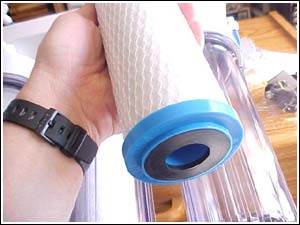

 |
||||||||||||
 |
||||||||||||
| RO Units: Parts and Their Functions | ||||||
| Page 7 of 9 | Pages: 1 . 2 . 3 . 4 . 5 . 6 . 7 . 8 . 9 | |||||
 Photo 24: Here's the connection between the final prefilter and the membrane housing. Note the use of 180 degree rotatable fittings. This keeps the hose from crimping and stopping the water flow.
Photo 24: Here's the connection between the final prefilter and the membrane housing. Note the use of 180 degree rotatable fittings. This keeps the hose from crimping and stopping the water flow.
 Photo 25: Here are the first two stages of the unit. They are spun polypropylene sediment filters. The one on the left is a 25 micron and the other is a 5 micron. They are designed to catch solid debris before it can foul the membrane.
Photo 25: Here are the first two stages of the unit. They are spun polypropylene sediment filters. The one on the left is a 25 micron and the other is a 5 micron. They are designed to catch solid debris before it can foul the membrane.
 Photo 26: Here is the third stage prefilter. It is a solid carbon block with 1 micron filtration. The purpose of this stage is dechlorination, microbal filtration and trapping of volitile organic chemicals in the feed water.
Photo 26: Here is the third stage prefilter. It is a solid carbon block with 1 micron filtration. The purpose of this stage is dechlorination, microbal filtration and trapping of volitile organic chemicals in the feed water.
Some makers will add a second carbon block in an effort to make their units appear better. The second is not needed in most municipal chlorinated water supplies and not at all in well applications where the water is not chlorinated. A second block can be used to help break the chlorine/ammonia bond in chloramine treated systems, allowing the membrane to reject most of the remaining ammonia. Granulated Activated Carbon should NOT be used prior to the membrane (as a prefilter) as the carbon dust remaining from manufacture may damage the membrane when the unit is first started. more... |
 |
|||||
| About Us :: Message Board :: Chat | |||||
| Library :: Photo Gallery :: Links & Resources :: Breeders & Sponsors :: Merchandise | |||||
| Website designed by: EthanCote.com | © 2001-2004, SimplyDiscus.com. All Rights Reserved. | ||||